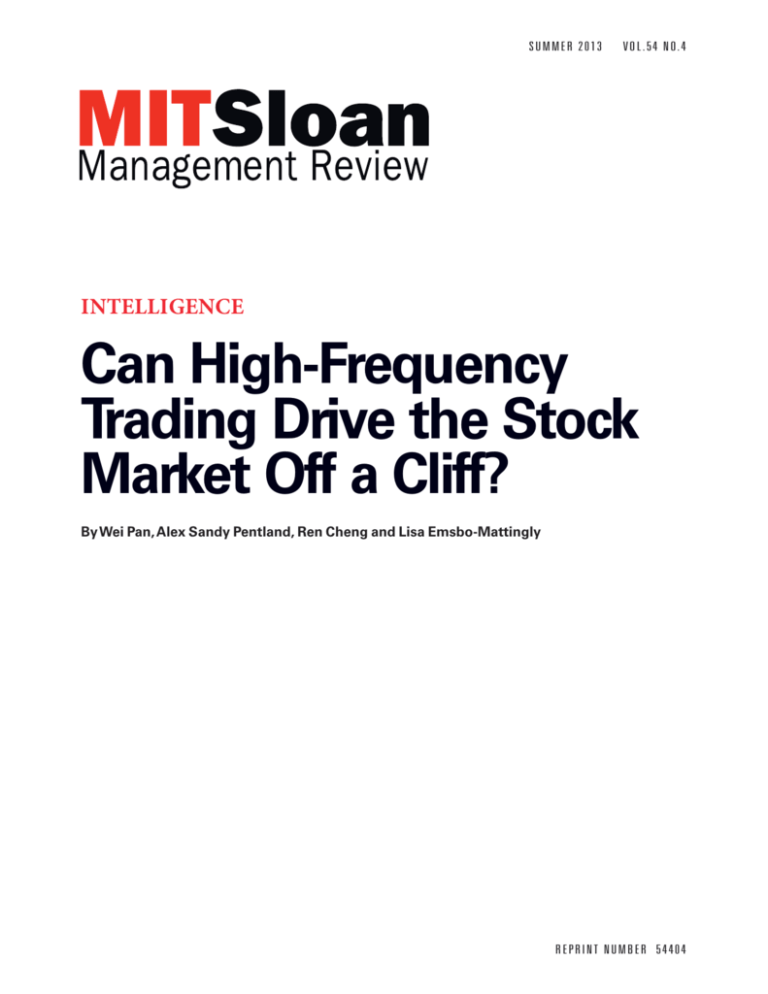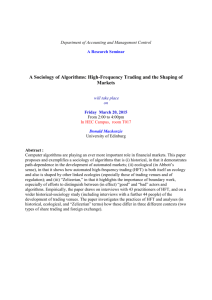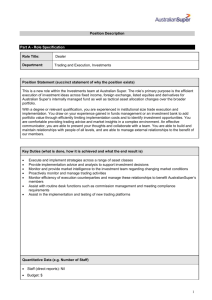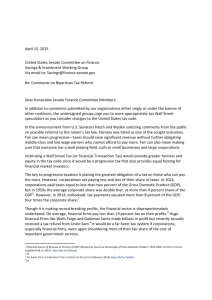
SUMMER 2013
V O L . 5 4 N O. 4
INTELLIGENCE
Can High-Frequency
Trading Drive the Stock
Market Off a Cliff?
By Wei Pan, Alex Sandy Pentland, Ren Cheng and Lisa Emsbo-Mattingly
REPRINT NUMBER 54404
INTELLIGENCE
[FINANCE ]
Can High-FrequencyTrading Drive the
Stock Market Off a Cliff?
Much of the time, high-frequency trading firms play a benign role in financial markets.
But in a nervous market with downward price pressure, high-frequency trading can
create fierce volatility.
BY WEI PAN, ALEX SANDY PENTLAND, REN CHENG AND LISA EMSBO-MATTINGLY
On May 6, 2010, at around 2:40 p.m., U.S.
stock market indices suffered a sudden
drop of 9%, evaporating over one trillion
dollars within 30 minutes. The event was
known as the “flash crash,” and it has been
the subject of much discussion and analysis since that time. The U.S. Commodity
Futures Trading Commission and the U.S.
Securities and Exchange Commission investigated the cause of the flash crash and,
in a September 2010 report, identified the
initial catalyst as a single large sell order,
with high-frequency trading then helping
accelerate the market decline. That conclusion, in turn, triggered fur ther
discussion, as some believe that the report
overstated the role of the single sell order.
However, there is no mystery behind the
price declines that occurred during the flash
crash: Price declines happen when there are
more sellers than buyers in the market.
Imagine a market composed of 10 sellers, all
eager to sell the same product, and with only
one buyer in the market. The only way sellers can compete for the sole buyer is to
reduce the price. The heated competition for
buyers created by the flash crash of 2010
temporarily took the stocks of some companies, such as Accenture PLC, to just a penny.
The real question is: What caused this sudden and violent imbalance between buy and
sell pressures during the flash crash?
Because the crash happened at a speed
beyond any human’s reaction time, many
people suspect that the high-frequency
trading industry was responsible for it.
High-frequency trading firms use fully
automated computer systems to buy and
sell stocks very rapidly — and make thin
profits by being ahead of human orders.
After conducting a computer simulation
of high-frequency trading behavior, we
have gained new insights into the role of
high-frequency trading in events like the
flash crash. This is our version of the story.
The Crowd and the Bridge
Our story begins with an analogy — to the
Millennium Bridge in London. When the
Millennium Bridge first opened in June
2000, as many as 2,000 people at a time
began to walk across the bridge. Shortly
16 MIT SLOAN MANAGEMENT REVIEW SUMMER 2013
after, they started to feel the bridge vibrate
and sway, with no apparent cause such as
wind or an earthquake. The bridge movement was so visually frightening that a video
of the event became popular on YouTube.
Authorities had to close, reengineer and
then reopen the bridge, a process that took
more than a year and a half. The cause, engineers later discovered, was the interaction
between the pedestrians and the bridge.
The problem was that the bridge could
not be stable if 2,000 people on the bridge
were moving in synchrony at the bridge’s
vibration frequency. During the opening,
when the bridge oscillated and shifted to
one side slightly, many pedestrians in the
crowd responded by instinctively shifting
Shortly after London’s
Millennium Bridge first
opened in June 2000, a
crowd of pedestrians
started to feel the bridge
vibrate and sway as they
walked across it.
COURTESY OF FLICKR USER TRP0
their weight to the other side of their bodies
in order to balance themselves. The packed
crowd also pushed against each other,
which reinforced the synchronization of
their movements. The power in their motion fed back to the bridge, causing even
more swings — and, in response, even more
synchronized human movements.
Synchronized Selling
Our simulation findings suggest that something analogous happened with highfrequency trading firms during the flash
crash, in that the firms became synchronized toward the sell side in a way that
increased market volatility. We know how
high-frequency trading firms trade in general from an earlier analysis of the trading
data from May 6, 2010, that was conducted
by researchers who were at the time affiliated with the CFTC. (See “Further
Reading.”) Using data from that analysis, we
could create strategies for 20 hypothetical
high-frequency trading firms. (The SEC and
the CFTC identified about 20 high-frequency trading accounts involved in the
crash.) These strategies essentially involve
buying and selling particular securities
frequently at different time intervals, an
approach known as mean reversion strategy.
Each high-frequency trading firm trades approximately every 10 to 20 seconds, buying
when the price goes down slightly and selling when the price goes up. High-frequency
trading firms are secretive — they do not
communicate with each other directly —
and consequently act independently.
We then fed the strategy of each of our
20 hypothetical high-frequency trading
firms into a computer and simulated their
behaviors, a method known as agentbased modeling. Because the experiment
was simulated, we could also compute
things one cannot measure in the real
world, such as the hypothetical prices in
the market assuming high-frequency
trading firms were not present.
(Continued on page 18)
SLOANREVIEW.MIT.EDU
SUMMER 2013 MIT SLOAN MANAGEMENT REVIEW 17
INTELLIGENCE
FURTHER READING
Can High-Frequency Trading Drive the Stock
Market Off a Cliff? (Continued from page 17)
What happened when we ran the model
assuming that real investors were trading
randomly — with half buying and half
selling? Good things. Under a simulation
with such circumstances, high-frequency
trading firms did not influence the market
price much and in fact made the market
smoother and less volatile. Some high-frequency trading firms were buying while
others were selling due to the diversity of
their strategies, and the market enjoyed
the abundance of liquidity by experiencing
smoother price changes.
But that scenario assumed a very calm
market. We also simulated a market with
more nervous market participants and, in
addition to random behaviors of real
investors, general strong downward pressure as people are trying to get out of the
market. That is more likely to reflect the
conditions of May 6, 2010. In the time
period between late April 2010 and the
flash crash, the NASDAQ index had
dropped 10%, and some mutual funds
were initiating large sell orders, creating
downward price pressure.
When we ran a simulation with such
downward price pressure, the hypothetical
market that did not include high-frequency trading firms declined slowly. But
the market price in the hypothetical market that included 20 high-frequency
trading firms appeared to be very similar
to an actual flash crash: It was stable for a
while — and then, suddenly, a crash occurred. Without the high-frequency
trading firms, the market would decline in
a more manageable and gradual fashion.
In our simulation, each high-frequency
trading firm had a limited budget, so that
no single entity could crash the market —
much as no individual alone could make
the Millennium Bridge sway perceptibly.
Much like the feedback loop between the
pedestrians and the Millennium Bridge,
high-frequency trades influenced the mar-
A.A. Kirilenko, A.S. Kyle, M.
Samadi and T. Tuzun, “The
Flash Crash: The Impact of High
Frequency Trading on an Electronic Market” (2010 working
paper, updated May 26, 2011).
Available at http://papers.ssrn.
com/sol3/papers.cfm?abstract_
id=1686004.
For more details about the authors’ simulation, see W. Pan, A.S.
Pentland, R. Cheng and L. EmsboMattingly, “High Frequency
Trading: A Simulation,” (working
paper, Dec. 20, 2012). Available at
http://web.media.mit.edu/
~panwei/pub/hft_smr.pdf.
ket price, which then affected the next
trades of the high-frequency trading firms.
As a result, many of these high-frequency
trading firms started to sell together, in synchrony, which added up to billions of
dollars worth of sell trades per second. This
was an event of enormous magnitude, even
for the U.S. equity market. The synchronized selling caused prices to collapse.
Our simulations suggest that the problems w ith hig h-frequency t r ading
synchronization occur when there is a trigger — strong downward pressure on the
market. (See “Further Reading” for more
details about our simulation.) Without
triggers, high-frequency trading firms remain benign — and even helpful — market
participants. When we gradually added
downturn pressure to price movements in a
hypothetical market with 20 high-frequency
trading firms and ran thousands of simulations, we found that the market remained
stable until downward drift hit a certain
threshold. We believe that the U.S. stock
market passed this threshold on May 6, 2010.
Lessons Learned
The common factor between the crowd
on the Millennium Bridge and the highfrequency trading firms in the stock market
is that both represent complex systems in
which many independent entities are
strongly interacting with each other either
directly or indirectly.
The lesson for those managing complex
systems is to be extremely cautious about
18 MIT SLOAN MANAGEMENT REVIEW SUMMER 2013
those systems’ behavior: They will often
react in ways that are surprising. Because
complex systems are interconnected and
contain feedback loops, their dynamics can
evolve into extreme phases. Most of the
time, a complex system will act in expected
ways, but it may turn into an unfamiliar
monster when an invisible tipping point is
passed. Since the extreme phases of these
systems may be rare, they are not well studied, and so are not always factored into
decision making.
For financial market makers, the lesson
is that synchronization of high-frequency
trading firms (such as synchronized selling)
must be monitored, and high-frequency
trading orders should be automatically
paused when synchronization levels hit a
threshold, such as three standard deviations
above normal activities. Similarly, systemic
risk tests should be conducted according
to the principles of complex systems —
looking at how elements of a system are
connected and how they act together under
such connection. We also believe that humans, both at high-frequency trading firms
and in regulatory agencies, should constantly monitor high-frequency trades.
Intuition is still better than computer models in handling complex cases.
Wei Pan is a doctoral student in the Human
Dynamics Group at the MIT Media Lab.
Alex “Sandy” Pentland is theToshiba
Professor of Media Arts and Sciences at the
Massachusetts Institute ofTechnology as
well as the director of the Human Dynamics
Group at the MIT Media Lab. Ren Cheng is a
senior research consultant at Fidelity Investments. Lisa Emsbro-Mattingly is director of
research in the global asset allocation division at Fidelity Investments.The views
expressed in this article are the authors’
personal views and opinions and do not
represent the official policy, view or position
of any institutions with which the authors
are affiliated. Comment on this article at
http://sloanreview.mit.edu/x/54404, or contact the authors at smrfeedback@mit.edu.
Reprint 54404.
Copyright © Massachusetts Institute of Technology,
2013. All rights reserved.
SLOANREVIEW.MIT.EDU
PDFs ■ Reprints ■ Permission to Copy ■ Back Issues
Articles published in MIT Sloan Management Review are
copyrighted by the Massachusetts Institute of Technology
unless otherwise specified at the end of an article.
MIT Sloan Management Review articles, permissions,
and back issues can be purchased on our Web site:
sloanreview.mit.edu or you may order through our
Business Service Center (9 a.m.-5 p.m. ET) at the
phone numbers listed below. Paper reprints are
available in quantities of 250 or more.
To reproduce or transmit one or more MIT Sloan
Management Review articles by electronic or
mechanical means (including photocopying or archiving
in any information storage or retrieval system) requires
written permission.
To request permission, use our Web site:
sloanreview.mit.edu),
or
E-mail: smr-help@mit.edu
Call (US and International):617-253-7170
Fax: 617-258-9739
Posting of full-text SMR articles on publicly accessible
Internet sites is prohibited. To obtain permission to post
articles on secure and/or password-protected intranet sites,
e-mail your request to smr-help@mit.edu.
Customer Service
MIT Sloan Management Review
238 Main Street E48-570
Cambridge, MA 02142







